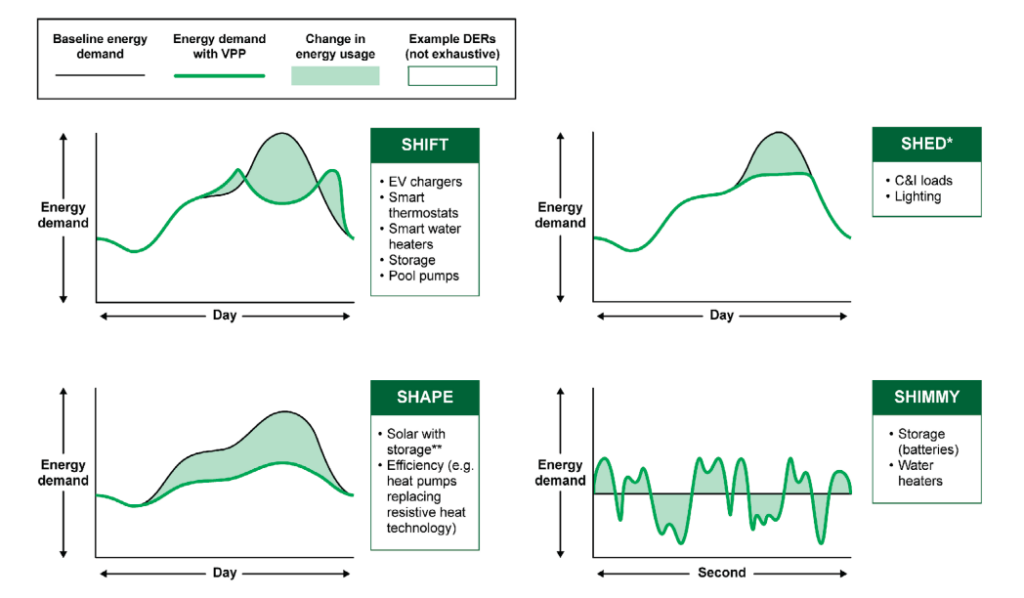The US Department of Energy (DoE) believes the nation can save as much as $10 billion in annual grid costs by 2030, simply by tripling the existing deployment of virtual power plants (VPPs). As the US ramps up sustainability processes in line with environmental targets VPPs are becoming an increasingly important factor in their success. President Joe Biden also set a goal to achieve a carbon-free electric grid by 2035 (currently 22.6% carbon-free) which further drives the interest in VPPs and other grid balancing technologies.
VPPs are aggregations of distributed energy resources (DERs), which are various forms of equipment in, and around, a building that can provide electricity demand flexibility, power generation, storage, or other energy services, typically at a small scale. By utilizing the various energy functions of such equipment, VPPs can balance electrical loads to support owner and grid goals, such as reducing grid consumption in peak load and cost times or selling electricity to neighbours and back to the grid. In that way, VPPs can act like a small power plant.
In smart buildings, VPPs may aggregate generation from rooftop solar and behind-the-meter energy storage systems, as well as the battery capacity of electric vehicles (EVs) via their charging infrastructure. The VPP will also aggregate building systems and their smart controls, including HVAC and lighting or electric water heaters and pumps. While commercial and industrial facilities that have the flexibility to shift their production time, can take advantage of lower electricity rates, which in turn also helps reduce peak load on the grid.

Typically, most consumers adopt DERs for a variety of functions unrelated to the national grid balancing benefits. They adopt smart technologies for the efficiency and human-centric benefits, they install EV chargers for compliance, staff retention, and green branding. Batteries, meanwhile, reduce cost and downtime, and onsite generation is primarily to save energy costs and profit from surplus. The markets for these technologies are maturing on their own merit to the building, the VPP model creates a virtual layer between these DERs and the grid to optimize the use, storage, and sale of available electricity for the building.
The revolutionary benefit of VPPs to the grid, however, is also undeniable. VPPs offer a low-cost method to manage high and variable electricity demand, and are highly configurable to meet the requirements of the local distribution or regional transmission grid. The key benefit of VPPs to the grid is their ability to reshape grid demand curves, not only reducing the overall power capacity required but also providing the stability to introduce more intermittent renewable energy sources and reduce US reliance on fossil fuels.
The graphs below show how VPPs can ‘shift, shed, shape, and shimmy’ to improve peak load for the sake of energy optimization of the building and the grid. Furthermore, as more VPPs are added to the network, the benefits continue to grow and grow for the grid, especially a grid with increasing contribution from intermittent renewable energy sources.

VPPs: Pathways to Commercial Liftoff
The DoE’s 79-page study, entitled ‘Pathways to Commercial Liftoff: Virtual Power Plants’, forecasts that the US will need to add 200GW of peak capacity between now and 2030 if it is just to keep up with demand growth. It also highlights the “unprecedented” growth of weather dependent renewable generation that will lead to more variable electricity supply and require further balancing. Without an energy revolution the US will struggle to keep up with demand, so VPPs and other cleantech are now becoming critical to maintain supply.
“Large-scale deployment of VPPs could help address demand increases and rising peaks at lower costs than conventional resources, reducing the energy costs for Americans – one of six of whom are already behind on electricity bills,” said the report. “VPPs also have the technical potential to perform a wider array of functions that contribute to resource adequacy at a low cost, increase resilience, reduce carbon emissions and transmission and distribution congestion, and can be adapted to meet evolving grid needs.”
Public pressure and increasingly destructive natural events have driven the political agenda in support of renewable energy and cleantech over the last decade or more, as well as their carbon-related targets. However, which technologies receive the kinds of support that would see them reach widespread adoption is often unclear in broad government initiatives. After years of much-needed political and regulatory support for renewable energy, we are now starting to see the same kind of attention on buildings and the grid to complete the energy revolution.
The growing attention on VPPs is testament to this development. VPPs rely on the existence of a modern grid infrastructure and on the connected DERs that typically reside in smart buildings. A world of abundant VPPs is a world of smart buildings and smart grids, and the DoE’s drive to increase VPP adoption will only be possible alongside policies and initiatives that also promote the development of smart buildings and grids.
As target dates approach for national environmental goals, the US and other governments are beginning to realize they need to step up their sustainability game, but physical barriers to capacity building still exist. Therefore, a virtual power plant, that you don’t need to physically build, has become a very attractive prospect for nations seeking to rapidly reduce reliance on fossil fuels to meet ambitious environmental goals.



